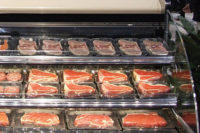A sight glass is commonly installed in the liquid line of systems that use a thermostatic expansion valve (TXV) metering device, and it allows technicians to view the condition of the refrigerant at the point where it is installed. So, where is the best location to install the sight glass in the liquid line? Ask several refrigeration technicians, and you will probably get several different answers.
If you install it close to the outlet of the condenser or condensing unit, you can determine if the refrigerant is in a subcooled state leaving the condenser or condensing unit. Of course, it will not tell you the degree of subcooling, just if is subcooled or not. Installing it at this location might be useful while charging or checking the charge of a system, but again, since it does not tell you the degree of subcooling, it should not be used as the final determination of a properly charged system.
Perhaps a better location is close to the inlet of the TXV. The refrigerant entering the TXV needs to be subcooled (no vapor) in order for it to feed the proper amount of refrigerant into the evaporator, so having the sight glass at this location will allow a technician to ensure the refrigerant is subcooled entering the TXV. Now, this is not the most convenient location, since it will likely be a good distance from the condensing unit or compressor, so at this location, using it as a charging aid would not be ideal. However, since it will allow you to visually confirm a subcooled refrigerant is entering the TXV, I believe it is the preferred location.
Next, should the sight glass be installed before or after the liquid line filter/drier? This discussion is a little more debatable. If the filter/drier is installed after the sight glass, it will be more difficult to determine if the filter/drier is restricted and sending a saturated refrigerant to the TXV. If the system charge is correct, the sight glass will be clear before entering the filter/drier, but the restriction could cause the refrigerant to go back to a saturated state and cause a saturated refrigerant to enter the TXV. However, if the filter/drier is installed before the sight glass, it will show the condition of the refrigerant leaving the filter/drier. But if there are bubbles in the sight glass, is it from a lack of refrigerant or a restricted filter/drier? That’s a little more difficult to determine.
One possible solution to this debate is to use two sight glasses and place one before and one after the filter/drier, but this adds an extra expense to the job, and is not commonly done. So, if you have to make a decision, I would opt for placing the filter/drier before the sight glass so you can be assured that the TXV is being fed a subcooled refrigerant.
Therefore, perhaps the best location for the sight glass is after the filter/drier and before the TXV.









